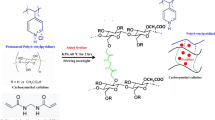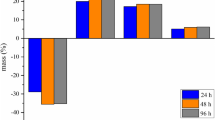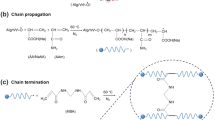Abstract
A slow-release fertilizer formulation was prepared by incorporation of urea in polyvinyl alcohol–alginate hydrogel core followed by deposition of calcium carbonate coating using HCO3−/CO32−-rich alkaline cell-free ureolytic culture broth. High urea encapsulation efficiencies were evident in both CaCO3-reinforced (23.48% w/w) and regular (38.71% w/w) hydrogel matrices. Deposition of carbonate over the matrix surface in the reinforced hydrogel was evident from scanning electron microscopy and typical FTIR band near 1465 cm−1 due to C–O stretch of carbonate ion. Aqueous phase release behaviour was not significantly different between the two hydrogel variants. In the soil column, two-stage urea release pattern (i.e. a slow followed by a fast) was eminent that can extend into hours. Therefore, the modified hydrogel for controlled release could be expected to have wide potential application as slow-release fertilizer in agriculture.





Similar content being viewed by others
References
Tomlinson I (2013) Doubling food production to feed the 9 billion: a critical perspective on a key discourse of food security in the UK. J Rural Stud 29:81–90. https://doi.org/10.1016/J.JRURSTUD.2011.09.001
Jie C, Jing-zhang C, Man-zhi T, Zi-tong G (2002) Soil degradation: a global problem endangering sustainable development. J Geogr Sci 12:243–252. https://doi.org/10.1007/BF02837480
Xiong ZQ, Freney JR, Mosier AR et al (2008) Impacts of population growth, changing food preferences and agricultural practices on the nitrogen cycle in East Asia. Nutr Cycl Agroecosyst 80:189–198. https://doi.org/10.1007/s10705-007-9132-4
Xue L, Yu Y, Yang L (2014) Maintaining yields and reducing nitrogen loss in rice–wheat rotation system in Taihu Lake region with proper fertilizer management. Environ Res Lett 9:115010. https://doi.org/10.1088/1748-9326/9/11/115010
Zhao X, Wang S, Xing G (2015) Maintaining rice yield and reducing N pollution by substituting winter legume for wheat in a heavily-fertilized rice-based cropping system of southeast China. Agric Ecosyst Environ 202:79–89. https://doi.org/10.1016/J.AGEE.2015.01.002
Tilman D, Cassman KG, Matson PA et al (2002) Agricultural sustainability and intensive production practices. Nature 418:671–677. https://doi.org/10.1038/nature01014
Jat RA, Wani SP, Sahrawat KL et al (2012) Recent approaches in nitrogen management for sustainable agricultural production and eco-safety. Arch Agron Soil Sci 58:1033–1060. https://doi.org/10.1080/03650340.2011.557368
Spiertz JHJ (2010) Nitrogen, sustainable agriculture and food security. A review. Agron Sustain Dev 30:43–55. https://doi.org/10.1051/agro:2008064
Dong D, Kou Y, Yang W et al (2018) Effects of urease and nitrification inhibitors on nitrous oxide emissions and nitrifying/denitrifying microbial communities in a rainfed maize soil: a 6-year field observation. Soil Tillage Res 180:82–90. https://doi.org/10.1016/j.still.2018.02.010
Zaman M, Blennerhassett JD (2010) Effects of the different rates of urease and nitrification inhibitors on gaseous emissions of ammonia and nitrous oxide, nitrate leaching and pasture production from urine patches in an intensive grazed pasture system. Agric Ecosyst Environ 136:236–246. https://doi.org/10.1016/J.AGEE.2009.07.010
Zaman M, Saggar S, Blennerhassett JD, Singh J (2009) Effect of urease and nitrification inhibitors on N transformation, gaseous emissions of ammonia and nitrous oxide, pasture yield and N uptake in grazed pasture system. Soil Biol Biochem 41:1270–1280. https://doi.org/10.1016/J.SOILBIO.2009.03.011
Ye Y, Liang X, Chen Y et al (2013) Alternate wetting and drying irrigation and controlled-release nitrogen fertilizer in late-season rice. Effects on dry matter accumulation, yield, water and nitrogen use. F Crop Res 144:212–224. https://doi.org/10.1016/j.fcr.2012.12.003
Guo M, Liu M, Zhan F, Wu L (2005) Preparation and properties of a slow-release membrane-encapsulated urea fertilizer with superabsorbent and moisture preservation. Ind Eng Chem Res 44:4206–4211. https://doi.org/10.1021/IE0489406
Naz MY, Sulaiman SA (2016) Slow release coating remedy for nitrogen loss from conventional urea: a review. J Control Release 225:109–120. https://doi.org/10.1016/J.JCONREL.2016.01.037
Shaviv A (2001) Advances in controlled-release fertilizers. Adv Agron 71:1–49. https://doi.org/10.1016/S0065-2113(01)71011-5
Timilsena YP, Adhikari R, Casey P et al (2015) Enhanced efficiency fertilisers: a review of formulation and nutrient release patterns. J Sci Food Agric 95:1131–1142. https://doi.org/10.1002/jsfa.6812
Wang Y, Liu M, Ni B, Xie L (2012) κ-Carrageenan–sodium alginate beads and superabsorbent coated nitrogen fertilizer with slow-release, water-retention, and anticompaction properties. Ind Eng Chem Res 51:1413–1422. https://doi.org/10.1021/ie2020526
Jin S, Wang Y, He J et al (2013) Preparation and properties of a degradable interpenetrating polymer networks based on starch with water retention, amelioration of soil, and slow release of nitrogen and phosphorus fertilizer. J Appl Polym Sci 128:407–415. https://doi.org/10.1002/app.38162
Rashidzadeh A, Olad A, Salari D, Reyhanitabar A (2014) On the preparation and swelling properties of hydrogel nanocomposite based on Sodium alginate-g-Poly (acrylic acid-co-acrylamide)/Clinoptilolite and its application as slow release fertilizer. J Polym Res 21:344. https://doi.org/10.1007/s10965-013-0344-9
Han X, Chen S, Hu X (2009) Controlled-release fertilizer encapsulated by starch/polyvinyl alcohol coating. Desalination 240:21–26. https://doi.org/10.1016/J.DESAL.2008.01.047
Wang Y, Liu M, Ni B, Xie L (2012) κ-Carrageenan–sodium alginate beads and superabsorbent coated nitrogen fertilizer with slow-release, water-retention, and anticompaction properties. Ind Eng Chem Res 51:1413–1422. https://doi.org/10.1021/ie2020526
Bortolin A, Aouada FA, Mattoso LHC, Ribeiro C (2013) Nanocomposite PAAm/methyl cellulose/montmorillonite hydrogel: evidence of synergistic effects for the slow release of fertilizers. J Agric Food Chem 61:7431–7439. https://doi.org/10.1021/jf401273n
An M, Lo KV (2001) Activated sludge immobilization using the PVA-alginate-borate method. J Environ Sci Heal Part A 36:101–115. https://doi.org/10.1081/ESE-100000475
Naz MY, Sulaiman SA (2014) Testing of starch-based carbohydrate polymer coatings for enhanced urea performance. J Coatings Technol Res 11:747–756. https://doi.org/10.1007/s11998-014-9590-y
Keeney D, Nelson D (1982) Nitrogen-inorganic forms. In: Miller RH, Keeney DR (eds) Methods of soil analysis part 2: chemical and microbiological properties, 2nd edn. Agronomy 9/2, American society of Agronomy, Madison
González ME, Cea M, Medina J et al (2015) Evaluation of biodegradable polymers as encapsulating agents for the development of a urea controlled-release fertilizer using biochar as support material. Sci Total Environ 505:446–453. https://doi.org/10.1016/j.scitotenv.2014.10.014
Douglas T, Wlodarczyk M, Pamula E et al (2014) Enzymatic mineralization of gellan gum hydrogel for bone tissue-engineering applications and its enhancement by polydopamine. J Tissue Eng Regen Med 8:906–918. https://doi.org/10.1002/term.1616
Douglas TEL, Łapa A, Samal SK et al (2017) Enzymatic, urease-mediated mineralization of gellan gum hydrogel with calcium carbonate, magnesium-enriched calcium carbonate and magnesium carbonate for bone regeneration applications. J Tissue Eng Regen Med 11:3556–3566. https://doi.org/10.1002/term.2273
Suzawa Y, Funaki T, Watanabe J et al (2010) Regenerative behavior of biomineral/agarose composite gels as bone grafting materials in rat cranial defects. J Biomed Mater Res 93A:965–975. https://doi.org/10.1002/jbm.a.32518
Han X, Chen S, Hu X (2009) Controlled-release fertilizer encapsulated by starch/polyvinyl alcohol coating. Desalination 240:21–26. https://doi.org/10.1016/J.DESAL.2008.01.047
Rahman MA, Oomori T (2009) In vitro regulation of CaCO 3 crystal growth by the highly acidic proteins of calcitic sclerites in soft coral, Sinularia Polydactyla. Connect Tissue Res 50:285–293. https://doi.org/10.1080/03008200802714933
Niu Y, Li H (2012) Controlled release of urea encapsulated by starch-g-poly(vinyl acetate). Ind Eng Chem Res 51:12173–12177. https://doi.org/10.1021/ie301684p
Shan L, Gao Y, Zhang Y et al (2016) Fabrication and use of alginate-based cryogel delivery beads loaded with urea and phosphates as potential carriers for bioremediation. Ind Eng Chem Res 55:7655–7660. https://doi.org/10.1021/acs.iecr.6b01256
Tao S, Liu J, Jin K et al (2011) Preparation and characterization of triple polymer-coated controlled-release urea with water-retention property and enhanced durability. J Appl Polym Sci 120:2103–2111. https://doi.org/10.1002/app.33366
Pereira EI, Minussi FB, da Cruz CCT et al (2012) Urea–montmorillonite-extruded nanocomposites: a novel slow-release material. J Agric Food Chem 60:5267–5272. https://doi.org/10.1021/jf3001229
Fidaleo M, Lavecchia R (2003) Kinetic study of enzymatic urea hydrolysis in the pH range 4–9. Chem Biochem Eng Q 17:311–318
Chen L, Xie Z, Zhuang X et al (2008) Controlled release of urea encapsulated by starch-g-poly(l-lactide). Carbohydr Polym 72:342–348. https://doi.org/10.1016/j.carbpol.2007.09.003
Author information
Authors and Affiliations
Contributions
Nisha Stanley is the first author of this study and was responsible for collecting the data, doing experiments and sample analysis. Biswanath Mahanty, the second and corresponding author, prepared the manuscript including graphs and figures. Both the authors equally contributed to the literature review, formulating background of the study. All authors have read and approved the final manuscript.
Corresponding author
Ethics declarations
Conflict of interest
No potential conflict of interest is reported by the authors.
Additional information
Publisher's Note
Springer Nature remains neutral with regard to jurisdictional claims in published maps and institutional affiliations.
Electronic supplementary material
Below is the link to the electronic supplementary material.
Rights and permissions
About this article
Cite this article
Stanley, N., Mahanty, B. Preparation and characterization of biogenic CaCO3-reinforced polyvinyl alcohol–alginate hydrogel as controlled-release urea formulation. Polym. Bull. 77, 529–540 (2020). https://doi.org/10.1007/s00289-019-02763-6
Received:
Revised:
Accepted:
Published:
Issue Date:
DOI: https://doi.org/10.1007/s00289-019-02763-6




